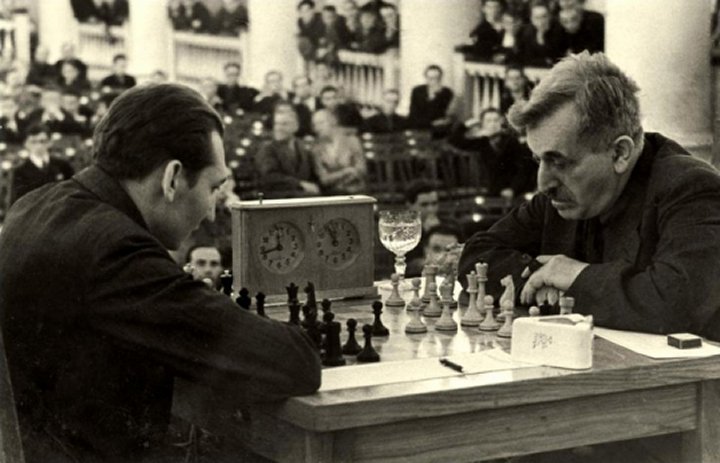Averbakh on Averbakh: How it all began
Moscow, February 1935. Dr. Emanuel Lasker is giving a simultaneous display for young players. For the Russians, young and old, the former world champion is a living legend.
He has had more than one sterling performance in their land, St. Petersburg 1895-96, 1909 and 1914, Мoscow 1925. Now he is here again to participate in the International Tournament in which Capablanca, his successor and their own champion Botvinnik would be playing.

Lasker seen in play with Eliksases, next year, Moscow 1936 | Photo: www.ChessPro.ru
A shy 13-year-old has come to watch the simultaneous display. His name is Yura. No, he is not here to play. Two of his friends, Isaac Linder and Alik Prorvich are participating in the event. He has come to cheer them. While Isaac loses, Alik manages to beat the former world champion, much to his delight. "I want to play like him," he muses. That gives him the impulse to study and improve his game.
Next year he joins Moscow Chess Club. Here he is fortunate enough to hear a lecture by Nikolai Grigoriev, an authority on the endgame. Years later he was to write,
"It made an unforgettable impression on me. When Grigoriev showed his pawn ending studies, moving the pieces on the demonstration board with his subtle artistic fingers one felt that one could sense the full depth and beauty of chess…I wanted to get into the game, understand its laws, its secrets."

Nikolai Grigoriev | Photo: https://chesspro.ru/_images/materials/2008/koroli1.jpg
So the lad is inspired and, especially, develops a taste for endgame theory and composition. When a tournament is held for problem solving, he participates and wins a prize. His trophy is Lasker’s Manual of Chess and he receives it from the hands of the former world champion himself!
Years pass. The boy grows up and becomes a grandmaster. He goes on to participate in the 1953 Candidates’ Tournament and also win the USSR Championship next year. Over years his tournament ambitions fade and he becomes the Editor of a prestigious chess magazine. Meanwhile he has taken to writing on the endgame. His series of books on the final phase of the game win wide acclaim and come to be used by generations of players.
Then his career changes once again and he becomes a chess administrator. It’s a powerful position involving many critical decisions. Controversy follows controversy, still his personal reputation remains intact.
This bland summary does little justice to the long and distinguished career of Yuri Averbakh who turned 100 the other day. So how is one to know the "real" Averbakh?
The life and times of the veteran grandmaster have yet to find their place in a proper biography. What we do have is his autobiography brought out by New in Chess Publishers a decade before.

Averbakh's autobiography (The Russian original work appeared under the title, Жизнь шахматиста в системе. Воспоминания гроссмейстера)
When this book was first released, it received both bouquets and brick bats. It was panned by critics (Taylor Kingston among others) for not revealing enough about what really happened behind the scenes or his own role that often remained among the shadows. While this criticism is not without merit, the book still deserves to be read.
As a witness to an era, Averbakh is uniquely qualified to write on all the events that took place in his time. Remember that he was no ordinary player. In his prime he overcame stalwarts like Keres and Euwe (the latter twice). In other encounters he also beat compatriots, Smyslov, Bronstein, Petrosian and Korchnoi, not to mention GMs like Larsen and Gligoric from the Western world.
His lasting legacy is his work on the endgame. One inspiration came from Nikolai Grigoriev whose examples are often mentioned in his writing. What could young Yura have found so fascinating in the lessons imparted by the great master?
Here is an example:
(solution next time!)
In the next part of this series we shall see how a fledgling talent blossomed into a mature grandmaster.
To be continued
Notes:
1) One limitation of this book is that there are no games in it. From this point of view, his other work, Averbakh's Selected Games (Cadogan.1998) deserves mention.
However, I have found Big DataBase also useful as it has many of the games mentioned by Averbakh in this book.
2) Botvinnik and Flohr shared first and second prize in Moscow 1935. Dr. Lasker finished third, half a point behind the winners and half a point ahead of Capablanca.
3) Isaac Linder was to become a renowned chess historian later. He is seen here at a felicitation programme for his old friend, Averbakh: https://rb.gy/rbinim
4) The other friend playing was Alik Prorvich (not "Alik Propvich" as it appears in the English translation here). Subsequently he became the Head of the Chess Section of the USSR Sports Committee.
5) Nikolai Grigoriev (1895-1938) was a fine player who crossed swords with contemporaries, Alekhine, Levenfish and Romanovsky among others in the early years of the USSR Championships.
He was a virtuoso in the final phase of the game and was a legendary composer of endgame studies. He weaved enchanting compositions with king and pawns.
He died relatively young and his last years were tragic. He was denounced as "an enemy of the state" and arrested by the NKVD during the Great Terror. A frail man, he bled profusely when his interrogators beat him. Then he was released and died of lung cancer next year.
An excellent book on the great master was published in 1954. It’s titled Шахматное творчество Н. Д. Григорьева ("The Chess Creative work of N. D. Grigoriev").
Links


























